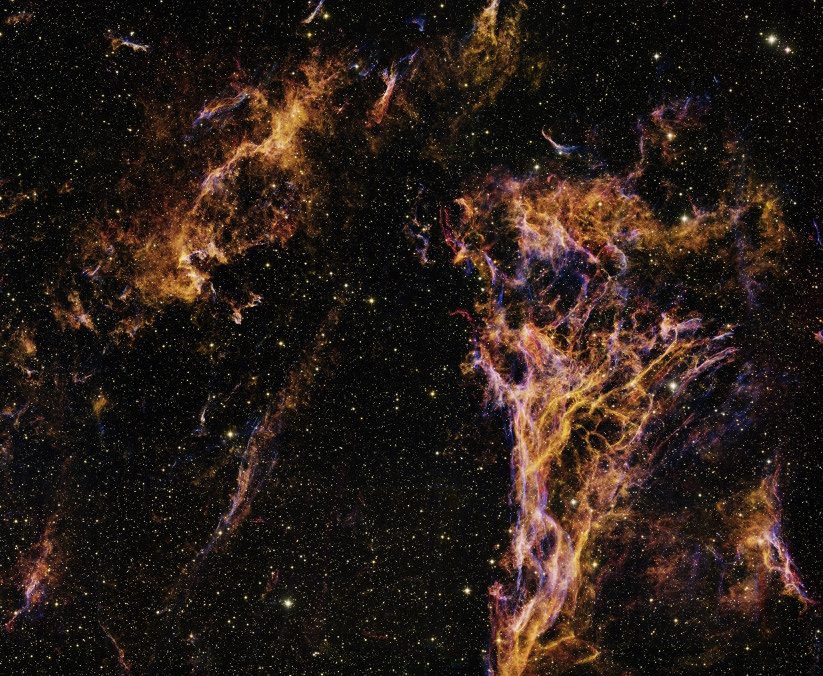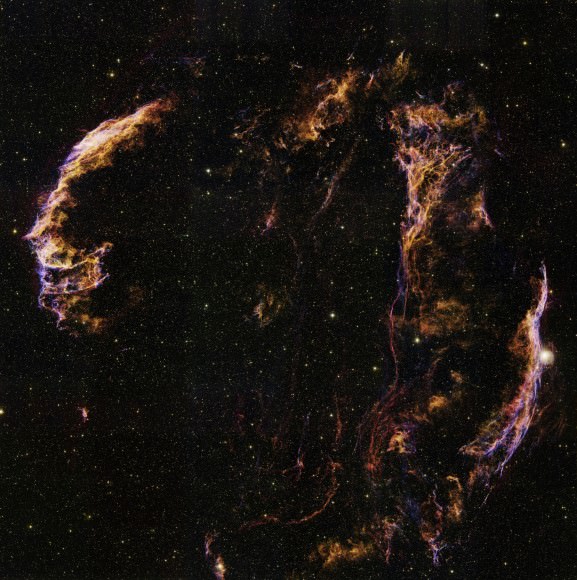Black holes often appear in science fiction movies, largely because elements of their existence are still a mystery. They have fascinating impacts on the surrounding region of space too with distortions in space and time high on the list. A team of astronomers have found a supermassive black hole with twin jets blasting out an incredible 23 million light years, the longest yet. To put this into context, if you lined up 140 Milky Way galaxies side by side, then that’s the length of the jet!
Continue reading “Astronomers Find the Longest Black Hole Jets Ever Seen”Enjoy the Holiday-Themed Christmas Tree Cluster

Just in time for the holidays, a new composite image of the Christmas Tree Cluster (NGC 2264) has been released. This image is a group effort: the blue and white stars in the cluster giving off X-rays are seen by Chandra, while the faint green nebula was imaged by the WIYN 0.9-meter telescope on Kitt Peak.
Continue reading “Enjoy the Holiday-Themed Christmas Tree Cluster”Astrophoto: Star Trails Over Kitt Peak
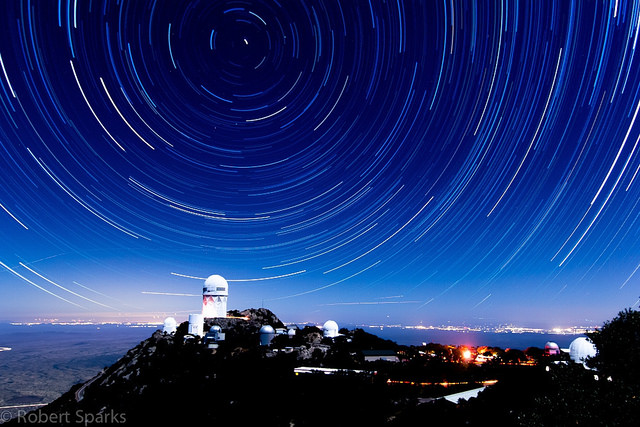
Our pal Rob Sparks said he had always wanted to try creating a star trails picture and this is his first attempt. Very nice! Of course, he had a great view of the telescopes on Kitt Peak in Arizona as a stunning foreground, (the lights of Tucson are to the right) but had to deal with a “nearly full Moon that night which illuminated the observatory and limited the exposure times,” Rob said on Flickr. “However, I am reasonably happy for a first try.”
We’re happy, too, as this is a lovely image. Thanks for sharing Rob!
You can read more details about the image on Rob’s website, The Half-Astrophysicist.
Want to get your astrophoto featured on Universe Today? Join our Flickr group or send us your images by email (this means you’re giving us permission to post them). Please explain what’s in the picture, when you took it, the equipment you used, etc.
Behind the Scenes at Kitt Peak Observatory: What is an Observing Run Really Like?
Greetings, from the Kitt Peak National Observatory, in Arizona! I’m here on a weeklong observing run, which is arguably the coolest and hardest part of the job.
Kitt Peak rests on the Quinlan Mountains, 6,880 feet above sea level and 55 miles southwest of Tucson. When you begin your drive up the mountain, you first see a beautiful panorama of glittering white domes. There are 26 telescopes on the Mountain.
The Mayall 4-meter telescope quickly catches your eye – the colossal giant that towers over the rest. As you continue your drive, a radio telescope can be seen on the left, followed by various signs stating that cell phone use is strictly prohibited. Observing runs here require radio silence, and a great chance to escape.
At the top of the mountain, two telescopes stand apart from the rest – the McMath-Pierce Solar Telescope and the WIYN observatory. The solar telescope reflects sunlight through a tunnel that leads underground. The WIYN observatory has an octagonal shape for a dome.
This is my third trip to Kitt Peak, but my first chance to observe on the Mayall 4-meter telescope. The first thing to know about the 4-meter is that it is a colossal maze. Literally. There are 16 stories of rooms, now obsolete and out of date, before reaching the base of the telescope itself.
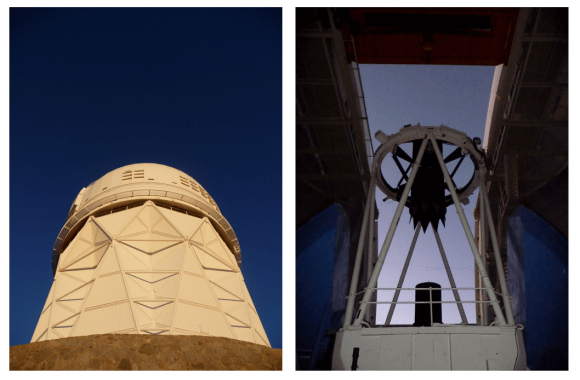
These rooms include old darkrooms, instrument rooms, machine rooms, classrooms, dormitories, game rooms, and other mysteries. We’ve been joking most of this week that Hollywood should rent out the 4-meter for a fantastic horror film. Just think: The Big Bang Theory meets Psycho.
On our first day here, my colleague and I managed to get pretty lost. To reach the telescope you have to take two different gated and locked elevators. But when we finally made it to the control room, we realized that this room alone is much more of maze than the building.
The control room consists of 4 computers, 16 monitors, 3 personal laptops, 4 tv screens, and an array of controls that operate the telescope. Eventually we became very comfortable floating from monitor to monitor.
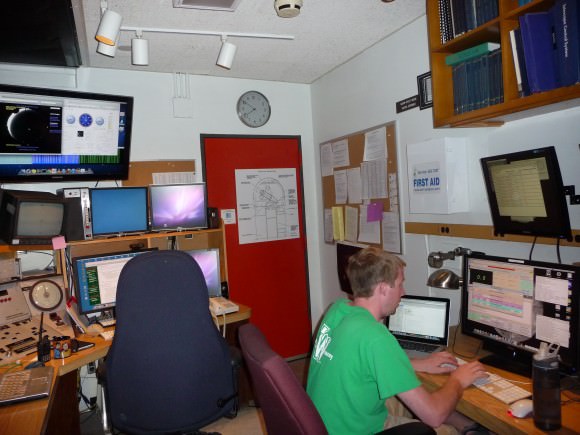
Here is what a typical day on an observing run looks like.
We typically wake up a little after noon and grumpily head to the dining hall for coffee. Breakfast (or lunch) runs until about 1 pm.
In the late afternoon, we take a few flat field calibrations – images of a white screen, which is uniformly lit up. Any variations in the final image are due to variations in the detector or distortions in the optical path. At the end of the day, you can divide your science images by your flat field images, in order to achieve much cleaner images.
Shortly thereafter, the dewar is filled with liquid nitrogen. This keeps the instrument cool (approximately -100 degrees Fahrenheit), as any thermal current can cause added noise.
After a quick dinner we return to the telescope. At this point sunset is approximately 2 hours away, but it’s already time to open the dome. When you’re standing next to the telescope, an opening dome sounds like a freight train screeching to a stop. It’s slightly terrifying, but it is by far one of my favorite sounds. It signifies that for the rest of the night you’re in control of this phenomenal instrument, which has the power to discover the secrets of the Universe.
After two hours of various preparations – making sure the telescope is pointing correctly, guiding correctly, etc. – we “get on sky.” Throughout the night the telescope operator controls the telescope, moving it to the fields we would like to observe, while we are in charge of taking the images by verifying the exposure time, filters to use, etc.
If everything goes smoothly the night is pretty easy. The telescope operator moves from target to target while we continuously take images. This means that we end up sitting in front of a computer screen, pressing enter every 300 seconds in order to start a new exposure. That’s really all it takes! Of course you should keep checking on your images in order to verify that they look good.
Around midnight it’s time for night lunch, a packed lunch that the dining hall provides. A little extra protein helps make the long nights more bearable. And then you push through, making coffee if necessary. The challenging part is staying awake throughout the night. It’s amazing how hard simple calculations can be when dawn is approaching.
At the end of the night you step outside and save for the flickering glint of Tucson’s city lights, the only noticeable light is found by looking up into the night sky. The stars here are brilliant, and the Milky Way is astonishing. After spending an entire evening stuck in a black box, it’s a wonderful reminder of what it’s all about: the night sky.
I observed with Dr. Mike DiPompeo, who concurred on what I noticed about the observing experience.
“When you first get into astronomy you’re in awe of the beauty of the night sky, compelled and driven by it,” DiPompeo told me. “But it can be easy to forget in the day to day business of being an astronomer – sitting at a computer, writing code, going through the data, reading papers – that your job is to understand that beauty. Observing reconnects you with the night sky.”
My favorite part of an observing run occurs in the morning – on the walk from the telescope to the dorm, when a yellow arch of light first appears above the horizon. Kitt Peak provides fantastic sunrises. And you really have to soak in every last ray of sun, before you crawl into bed in a very dark room.
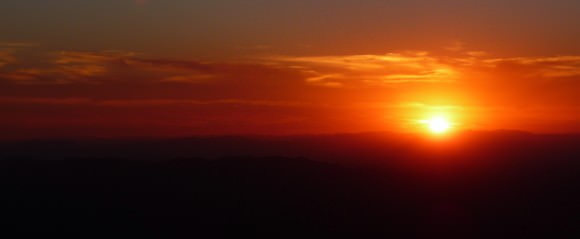
Observing runs lie at the root of pure research. You spend the long nights collecting data, then the months or years analyzing the data, and finally hope that a cool result comes from all the hard work.
A Parting Look at 2012 DA14: Was This a Warning Shot from Space?
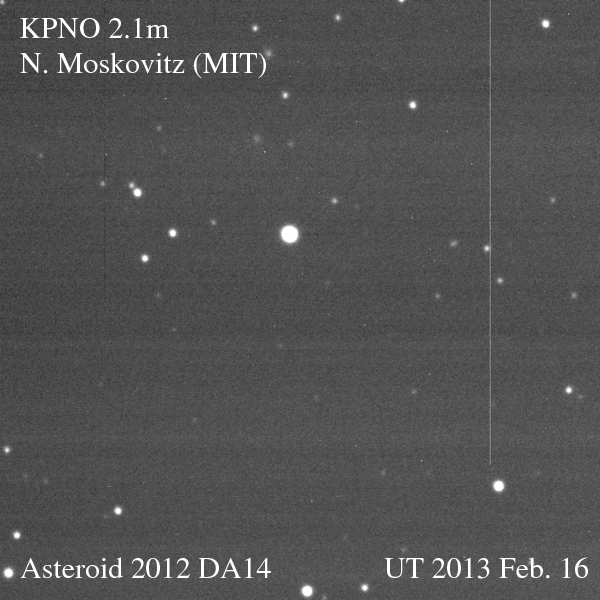
Just as anticipated, on Friday, Feb. 15, asteroid 2012 DA14 passed us by, zipping 27,000 kilometers (17,000 miles) above Earth’s surface — well within the ring of geostationary weather and communications satellites that ring our world. Traveling a breakneck 28,100 km/hr (that’s nearly five miles a second!) the 50-meter space rock was a fast-moving target for professional and amateur observers alike. And even as it was heading away from Earth DA14 was captured on camera by a team led by MIT researcher Dr. Nicholas Moskovitz using the 2.1-meter telescope at the Kitt Peak National Observatory in Tucson, AZ. The team’s images are shown above as an animated gif (you may need to click the image to play it.)
This object’s close pass, coupled with the completely unexpected appearance of a remarkably large meteor in the skies over Chelyabinsk, Russia on the morning of the same day, highlight the need for continued research of near-Earth objects (NEOs) — since there are plenty more out there where these came from.
“Flybys like this, particularly for objects smaller than 2012 DA14, are not uncommon. This one was special because we knew about it well in advance so that observations could be planned to look at how asteroids are effected by the Earth’s gravity when they come so close.”
– Dr. Nicholas Moskovitz, MIT
The animation shows 2012 DA14 passing inside the Little Dipper, crossing an area about a third the size of the full Moon in 45 minutes. North is to the left.
(For a high-resolution version of the animation, click here.)
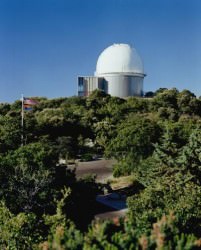
According to the National Optical Astronomy Observatory, which operates the Kitt Peak Observatory, Dr. Moskovitz’ NSF-supported team “are analyzing their data to measure any changes in the rotation rate of the asteroid after its close encounter with the Earth. Although asteroids are generally too small to resolve with optical telescopes, their irregular shape causes their brightness to change as they rotate. Measuring the rotation rate of the asteroid in this way allows the team to test models that predict how the earth’s gravity can affect close-passing asteroids. This will lead to a better understanding of whether objects like 2012 DA14 are rubble piles or single solid rocks.
“This is critical to understanding the potential hazards that other asteroids could pose if they collide with the Earth.”
So just how close was DA14’s “close pass?” Well, if Earth were just a few minutes farther along in its orbit, we would likely be looking at images of its impact rather than its departure.*
Although this particular asteroid isn’t expected to approach Earth so closely at any time in the foreseeable future — at least within the next 130 years — there are lots of such Earth-crossing objects within the inner Solar System… some we’re aware of, but many that we’re not. Identifying them and knowing as many details as possible about their orbits, shapes, and compositions is key.
Even this soon after the Feb. 15 flyby observations of 2012 DA14 have provided more information on its orbit and characteristics., allowing for fine-tuning of the data on it.
According to the Goldstone Radar Observatory web page, the details on 2012 DA14 are as follows:
Semimajor axis 1.002 AU
Eccentricity 0.108
Inclination 10.4 deg
Perihelion distance 0.893 AU
Aphelion distance 1.110 AU
Absolute magnitude (H) 24.4
Diameter ~50 meters (+- a factor of two)
Rotation period ~6 h (N. Moskovitz, pers. comm.)
Pole direction unknown
Lightcurve amplitude ~1 mag (N. Moskovitz, pers. comm.)
Spectral class Ld (N. Moskovitz, pers. comm.)
Goldstone is currently conducting radar observations on the asteroid. A radar map of its surface and motion is anticipated in the near future.
Read more about Dr. Moskovitz’ observations on the NOAO website here, and see more images of 2012 DA14 captured by astronomers around the world in our previous article.
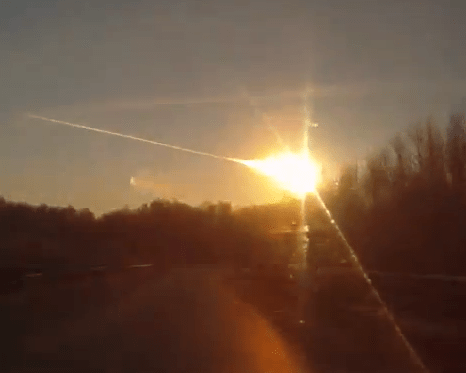
Also, in an encouraging move by international leaders in the field, during the fiftieth session of the Scientific and Technical Subcommittee of the Committee on the Peaceful Uses of Outer Space, currently being held from at the United Nation Office in Vienna, near-Earth objects are on the agenda with a final report to be issued by an Action Team. Read the report PDF here.
*According to astronomer Phil Plait, while the orbits of Earth and DA14 might intersect at some point, on the 15th of February 2013 the asteroid slipped just outside of Earth’s orbit — a little over 17,000 miles shy. “It was traveling one way and the Earth another, so they could not have hit each other on this pass no matter where Earth was in its orbit,” he wrote in an email. Still, 17,000 miles is a very close call astronomically, and according to Neil deGrasse Tyson on Twitter, it “will one day hit us, like the one in Russian [sic] last night.” When? We don’t know yet. That’s why we must keep watching.
A Cosmic Rose for Your Spacey Valentine
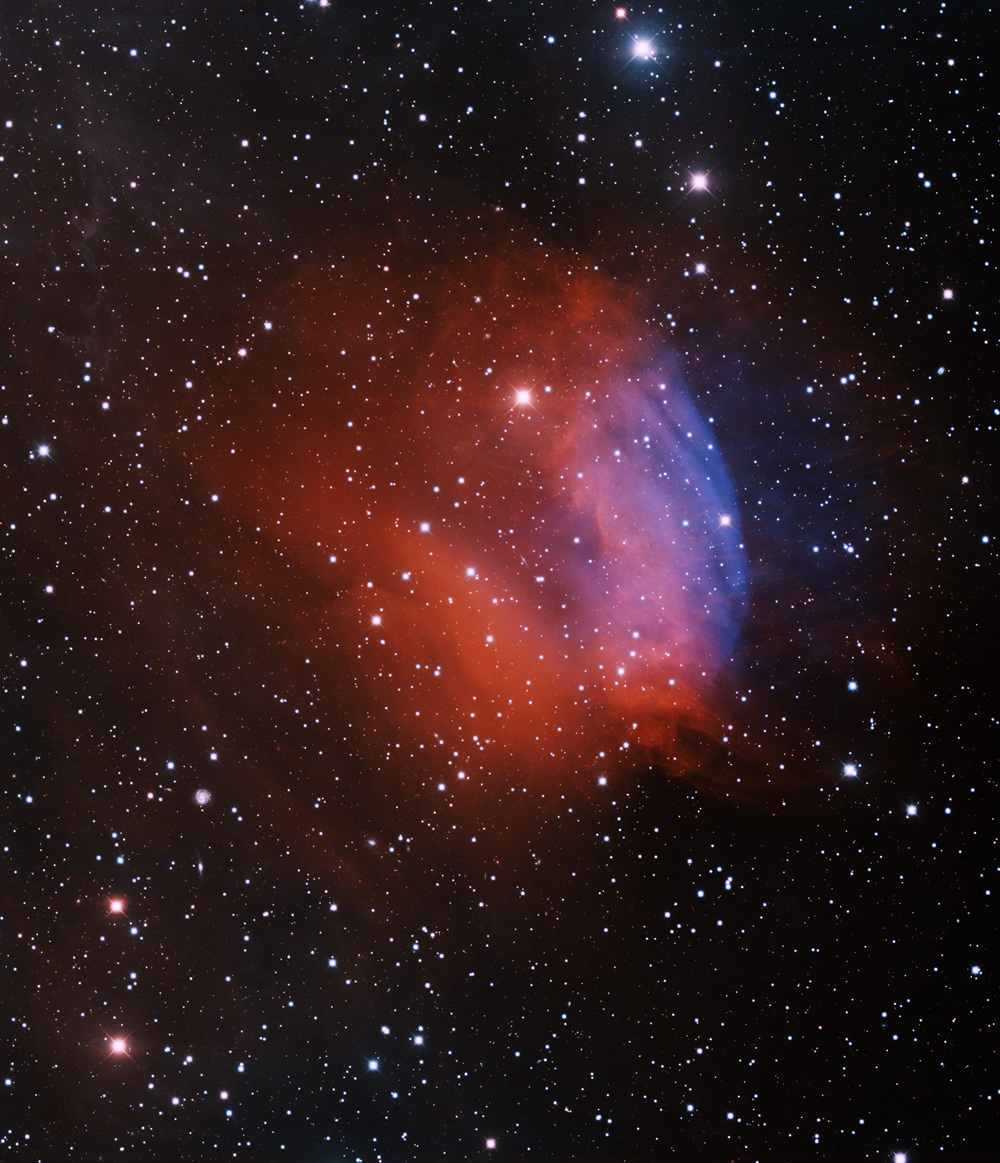
We space-nerds like to express our amorous feelings, just like the rest of the population (although admittedly some of need more help/prodding in this area than others). And so just in time for Valentine’s Day comes this new image of a planetary nebula, which looks like a rose — or even a tulip – to share with your very spacey valentine.
The name of this planetary nebula, however, is not so romantic: Sh2-174. We need some suggestions for a better name!
And the way this object was created is not so romantic, either, as planetary nebulae come about in violent events. Sh2-174 was created when a low-mass star blew off its outer layers at the end of its life. The core of the star remains and is called a white dwarf. Usually the white dwarf can be found very near the center of the planetary nebula. But in the case of Sh2-174 it is off to the right. (It is the very blue star near the center of the blue gas). This asymmetry is due to the planetary nebula’s interaction with the interstellar medium that surrounds it.
This image was obtained with the wide-field view of the National Optical Astronomy Observatory (NOAO) Mosaic 1 camera on the Mayall 4-meter telescope at Kitt Peak National Observatory. Travis Rector from the University of Alaska Anchorage made the observations for this image, taken through four different filters which are assigned colors that approximate what the human eye can see: B (blue), I (orange), Hydrogen-alpha (red) and Oxygen [OIII] (blue) filters. In this image, North is up, East is to the left.
Source: NOAO
One of the Largest Astronomical Images Ever Made
The northern portion of the Cygnus Loop, as seen in an enormous new panorama from the National Optical Astronomy Observatory (NOAO) and WIYN partners
Looking for a stunning new desktop image to wrap up the year? Try this: it’s an amazing panorama of the Cygnus Loop, a supernova remnant located 1,500 light-years away in the constellation (you guessed it) Cygnus. The full-size image, acquired with the wide-field Mosaic camera on the WIYN 0.9-meter telescope at Kitt Peak, Arizona, is a staggering 600 million pixels in size — over 1.68 gigabytes — making it one of the largest astronomical images ever made!
See the full image (and links to download larger versions) below:
2000-pixel-wide version of the full Cygnus Loop panorama
The entire structure of the Cygnus Loop, the gaseous remains of a supernova that occurred 5,000 – 10,000 years ago, covers an area nearly 45 times the size of the full Moon in the sky.
In the image, hydrogen alpha, sulphur, and oxygen ions correspond to the red, green, and blue color values, respectively.
“Images like this are amazing because they can remind you of the big picture and beauty that surrounds us.”
– Dr. Richard Cool, MMT Observatory
From the NOAO press release:
Astronomers estimate the supernova explosion that produced the nebula occurred between 5,000 to 10,000 years ago. First noted in 1784 by William Herschel, it is so large that its many parts have been catalogued as separate objects, including NGC 6992, NGC 6995 and IC 1340 along the eastern (left) side of the image, NGC 6974 and NGC 6979 near the top-center, and the Veil Nebula (NGC 6960) and Pickering’s Triangle along the western (right) edge. The bright star near the western edge of the image, known as 52 Cygnus, is not associated with the supernova.
“Often, astronomical research reduces images to dry tables of numerical information that we analyze in order to more deeply understand our universe,” said Dr. Richard Cool, astronomer at the MMT Observatory in Arizona, who originally obtained the images in 2003 while still a graduate student. “Images like this are amazing because they can remind you of the big picture and beauty that surrounds us.”
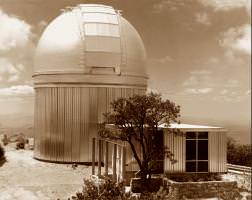 This incredible image demonstrates that even relatively small telescopes are capable of producing cutting-edge research, when equipped with modern cameras.
This incredible image demonstrates that even relatively small telescopes are capable of producing cutting-edge research, when equipped with modern cameras.
Got bandwidth to spare? Download the full-size 1686.5 MB TIFF image here, or find other versions on the NOAO page here.
Image Credit: T.A. Rector (University of Alaska Anchorage), Richard Cool (University of Arizona) and WIYN/NOAO/AURA/NSF. Inset image: original dome of the Kitt Peak 0.9-meter telescope. (NOAO/AURA/NSF)



